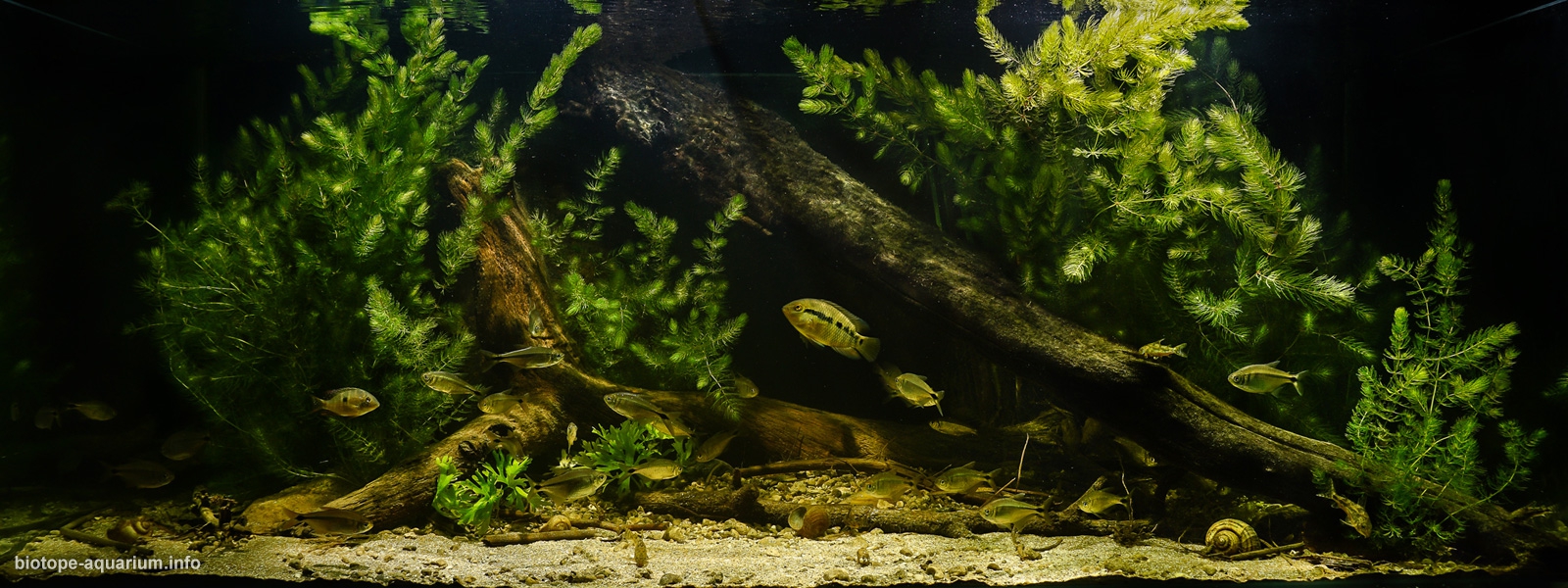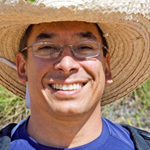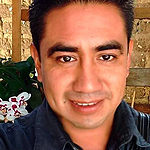Banks of the El Espinillo creek in the dry season, Magdalena, Buenos Aires, Argentina
1st place in Biotope Aquarium Design Contest 2018
![]() Argentina. Walter Vázquez
Argentina. Walter Vázquez

Volume: 540 L
Dimensions: 150x60x60 cm
List of fishes: Astyanax stenohalinus, Australoheros facetus, Bryconamericus iheringii, Corydoras paleatus, Gymnogeophagus meridionalis, Pimelodella laticeps
List of plants: Ceratophyllum demersum, Ranunculus apiifolius, Schoenoplectus californicus
Description of decorations: All the elements used in this aquarium, such as the substrate, wood, vegetable detritus, stones, rocks, empty shells of snails and bivalves and plants, were collected from the aquatic system and arranged to imitate the chosen biotope and likewise to be able to maintain and learn more about it through a wild aquarium at home. The substrate of the aquarium is very fine sand with silt-clayey consistency of brown color. In it you can find remains of ground shell. It has deposits of vegetable detritus with remains of wood, rushes, remains of thistles and grass that falls from the fields that surround it.
Description of equipment: The aquarium is equipped with 2 Atman 3338 canister filters, with biological and mechanical material. The aquarium lighting is based on 3 led 6000k reflectors.
Water parameters: Aquarium water looks clear. The aquarium is kept at room temperature at about 20°C at this time of year. The parameters of the water are 8.0pH and the hardness of the carbonates is 10dH. These pH and hardness values are reached thanks to the use of the same substrate of the aquatic system.
INFORMATION ABOUT BIOTOPE
Description of the area surrounding the biotope: “El espinillo” creek is tributary of the “Río de la Plata”, is located in the Magdalena district, province of Buenos Aires, in the Argentine Republic. The location coordinates of the stream are 35 ° 08’08.7 “S, 57 ° 42’35.2” W. In general it is fed by rains fallen in the vicinity and by springs, contributing also the contribution of groundwater in some areas of the basin. The Espinillo creek has the peculiarity that in its middle section develops the “Cañada de Arregui”, a group of poor drainage areas, interconnected by more depressed areas of permanent and temporary regime. In its middle sector, it forms a flat depression, permanently flooded of scarce depth, the lagoon of Arregui. In its surroundings you can also find a diverse terrestrial fauna.
Many species of birds inhabit the place, such as Ciconia maguari, Cisne coscoroba, Pseudoleistes virescens and Sturnella superciliaris. The area is also inhabited by populations of Myocastor coypus, which make their caves and nests along the banks of the creek and the reed beds. The contribution of plant detritus from the creek “El Espinillo” generally comes from the grasslands and bushes that surround it during its course. However, the scarce slope causes the stagnation of the water in the dry season and increase in transparency, which favors the development of numerous submerged and floating plants in the backwater area. Associated with the vegetation can be found bivalves like concentric Gundlachia and ampullar as Pomacea canaliculata; It is common to find on the substrate a good amount of empty shells of the latter mentioned because they are the food of several species of birds that live in the vicinity of the creek. There are also abundant cladocerans and copepods, as well as dipterous larvae.
Description of the underwater landscape of the biotope: It is approximately 30 kilometers long with an average depth of 60 or 70 cm approximately in its deepest part in the dry season. It flows into the Río de la Plata. It is of slow course and the clarity of the water varies according to the zones and the amount of water that it drags. During periods of heavy rain, it can reach heights in the depth meter, causing it to overflow and flood the surrounding fields. It has a scarcely sloping channel, the substrate is characterized by the predominance of silty-clayey sediments, with abundant organic detritus, dug in Cenozoic sedimentary deposits of scarce current. The edges are determined by slight ravines.
Description of the parameters of the habitat: Its waters are slightly alkaline in natural form, with pH 8 and a hardness of water of 10° dh. due largely to the calcareous substrate (Tosca). The hardness of the water is high and also the conductivity, which can fluctuate depending on the land it crosses, by contributions of the groundwater that in some cases can be strongly mineralized, by the existence of exposed coastal strips, after the descent of the old ” Querandinense Sea “, which have a large percentage of shell in its composition, or because of the influence of pollution by intensive livestock in the area.
The temperature of the water in the dry season in the middle of March gave a value of 22ºC. The values of No2 resulted in 0 mg / L and the No3 values with an approximate value of 12.5 mg / L. (These values were surveyed with tests for aquariums).
List of fishes and invertebrates occurring in the nature biotope: The waters of this creek have good aquatic diversity, abundant in the dry season. Fish of the Characidae families can be found, such as Astyanax stenohalinus (Messner, 1962), Bryconamericus iheringii (Boulenger, 1887) and Oligosarcus oligolepis (Steindachner, 1867); Crenuchidae as Characidium rachovii (Regan, 1913); Cichlidae such as Australoheros facetus (Jenyns, 1842), Crenicichla scottii (Eigenmann, 1907) and Gymnogeophagus meridionalis (Reis and Malabarba, 1988); Erythrinidae as Hoplias malabaricus (Bloch, 1794); Callichthyidae as Corydoras paleatus (Jenyns, 1842) and also species of the family Heptapteridae as Pimelodella laticeps (Eigenmann, 1917). Also found in large quantities, crustaceans such as Palaemonetes argentinus (Nobili, 1901). In the rainy season, the species of fish that inhabit this creek diminish considerably, due to the low temperatures (less than 10 ° C) that reach its waters, and perhaps also, due to the great sedimentation that drags the system at this time of the year.
List of plants found in the nature biotope: Juncales (Schoenoplectus californicus), associated with other marsh plants such as Typha dominguensis and Solanum malacoxylum, are found along the creek. Among the submerged or floating plants can be found Ceratophyllum demersum, Myriophyllum elatinoides. Potamogeton striatus, Potamogeton sp., Chara sp., Lemnaceae, Ludwigia peploides, Hydrocotyle ranunculuides and Ranunculus apiifolius.
Sources of information: All the information gathered in this work comes from the personal on-site survey of this water system, which was turned into a web page and a Facebook fan page. In them you will find photographs and videos of the area made by me and my partner in the project.
– https://www.facebook.com/
– https://proyectoespinillo.
– The specific information on the Limnological characteristics was consulted in the following links and articles.
– http://www.alestuariodelplata.
– http://petmagdalena.blogspot.
– A benthic view of streams and Pampean Rivers – A. Rodrigues Chapter, C. S. Ocon and M. Tangorra (Institute of Limnology “Dr. Raúl A. Ringuelet”)
Comments of the members of the jury of Biotope Aquarium Design Contest 2018

This is my one of favourite participations on this year. You’ve researched habitat very well. Photos and videos are pretty high quality. I liked your style of using materials in this aquarium. You could make design more deep but it still looks good enough. Congrats.

Simple is beautiful. This aquarium shows the beauty of Ceratophyllum demersum, but I would like to see more variety since it’s a large aquarium with enough width and depth. It seems that Ranunculus was planted recently. Also, the whole atmosphere seems a little dark, especially when the video, in the beginning, shows open waters only with reed. Don’t get me wrong, I like it very much and this is an example of correct biotope research, but I would push aesthetics a little bit more.

How wonderful it is to see an Argentinean biotope – one very poorly represented compared to other South American countries, yet very deserving at that. I love so many things about this aquarium – that it combines characins, catfish and cichlids that it mixes more than one cichlid species, and that is essentially temperate, and could exist in many people’s homes without a heater. Ceratophyllum demersum is an underused plant in biotopes yet it occurs naturally in so many places all over the world. The décor is great, even down to the snail shells, and the tank is well lit and well shot. I would love to have this special biotope aquarium in my home. My favourite tank.
Perfect example of natural looking tank, which is also aesthetically pleasing to the eye. Lots of space for fishes, which is very important. Separate congratulations should go to the video showing the tank – it’s perfectly done, one can barely notice when the view changes from nature to aquarium!

The green makes it what it is, a soothing spectacle to the eyes! This biotope aquarium drew my attention because Walter Vázquez made a great fusion of old school aquaria with the natural twist that makes this new biotope movement so cool and different. This aquarium is a rebel, an icon, the leap into the new era of biotopes.

It is a very beautiful aquarium without doubt. The arrangement of all the elements looks natural. The difference of textures in the substrate allows understanding the idea of the current zone and the area of accumulation of drag material next to the vegetation. As a suggestion I would only recommend a little less brightness in the photograph, but in general it is a great job. Congratulations!

This biotope is almost a perfect model for viability. The behaviour of the fish tells us much about their comfort level. All fish are calm, active, and vibrant, doing their instinctual behaviours – schooling, foraging, and displaying. None are breathing hard or swimming against the glass. They have been provided with zones matching their adaptations and stay within these zones, the Corys dusting off the branches and stones, cichlids sifting mouthfuls of sand, and tetras sheltering among the driftwood overhangs, each alongside and harmonious with the others, occupying the niches they have adapted to over millions of years. There are open areas for display balanced with shaded areas to hide. The compatibility of the fish is evidenced by the total ease of their interactions.

I like your style and the depth of your research. Interesting biotope, nice balance, color, light. What biotoping should be!
